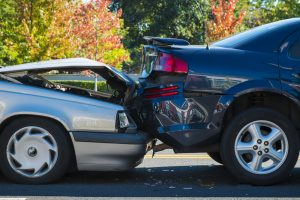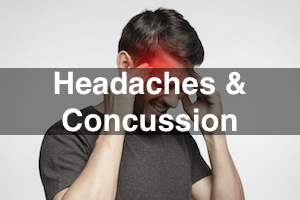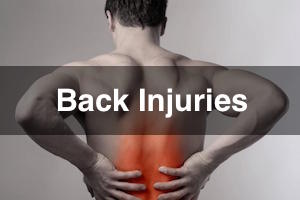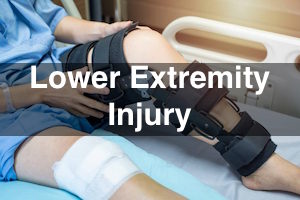According to the National Highway Traffic Safety Administration (NHTSA), rear end car accidents are the most common type of motor vehicle accident. In fact, in Florida, more than 100,000 rear end accidents occur annually accounting for one in every four auto collisions. The majority of these rear end car accidents happen as a result of the lead driver stopping suddenly while the rear driver was following too closely.

While the majority of rear end car accidents do not result in severe damages to either vehicle, the shear force of the rear vehicle hitting the lead one can often lead to serious and long term physical injuries to the vehicle's occupants that can impact their physical capabilities throughout the entirety of their life. Common injuries caused by rear end car accidents include whiplash, head injuries, neck injuries, back injuries, as well as leg sprains or fractures. If you are ever in a rear-ended car accident, keep reading below to learn details about each of these injuries.
Most Common Injuries Caused By Rear End Car Accidents
Whiplash
Whiplash is a neck injury that often results from a rear-end car accident. It happens to be the most common form of injury suffered in rear end car accidents. When the force of the impact causes your head to be jerked forward and then backward, it can cause pain and stiffness in your neck due to strained ligaments, torn muscles, and/or fractured bones.

Since the impact of rear end car accidents propels the head forward suddenly, it can strain and damage the soft tissues in the neck and cause them to become sore and inflamed. Victims may go on to experience headaches, dizziness, blurred vision, ringing in their ears, fatigue, difficulty concentrating and sleeping issues as a result. If not addressed promptly, these whiplash symptoms have the potential to persist for several months or even years after rear end car accidents. Treatment typically involves rest, physical therapy, and anti-inflammatory medications or even injections.
It’s important to seek medical attention immediately after being a victim of any kind of car accident, particularly rear end car accidents, even if you don’t feel much pain or discomfort at the time. Whiplash symptoms may present themselves gradually over time, so it’s important to protect yourself by visiting a doctor right away even if you have not started experiencing neck pain or stiffness. When symptoms do emerge, with preventative measures such as regular physiotherapy and wearing a neck brace, and taking anti-inflammatories, victims can minimize their risk of long-term side effects from whiplash caused by those rear end car accidents.
Headaches and Concussions
Headaches and concussions are also common injuries associated with rear end car accidents. If your head is quickly snapped back and forth with sufficient force, then it can cause you to suffer from a concussion due to the rapid acceleration and deceleration of your brain that can sometimes involve the brain hitting the skull. Severe cases of concussions may even cause permanent damage to the brain.

The headaches due to a head injury can result through anything from tissue damage in the spinal column, whiplash, or even muscle spasms in the neck. Treatment for headaches varies depending on the severity and can include medications, rest, or mental health counseling for post-concussion syndrome.
In addition to experiencing headaches when someone has been hit in a rear end collision, they may also experience a concussion due to the sudden impact of rear end collisions. A concussion can be mild or severe depending on a number of factors such as speed on impact and bumper height/weight. Symptoms such as dizziness, confusion, nausea, loss of balance, fatigue, memory issues and changes in cognitive functioning can all be signs that a concussion has occurred. Seeking medical treatment right away is essential for making sure you are properly diagnosed and treated. The sooner the injuries are diagnosed and treated, the more likely your full recovery will be.
Additionally, if you decide to pursue legal action against the other driver responsible for the accident, you'll need evidence of your injury in order to receive compensation. Having access to medical records proving that you suffered a head injury due to rear end car accidents can also be helpful when negotiating with insurance companies.

South Florida Victims . . .
NEED HELP WITH A REAR END ACCIDENT?
Neck Injuries
Neck injuries can occur when the force of a rear-end car accident causes whiplash. Symptoms such as pain, tenderness and stiffness in the neck can be felt immediately or within days of the accident. If left untreated, these symptoms could linger for weeks or even months. Even if you're not experiencing neck pain after a rear end crash, seek medical attention right away to prevent any further damage and to protect your rights if you ever need to pursue legal action.

Common treatment for neck pain caused by rear end car accidents includes rest and over-the-counter pain medications such as ibuprofen, naproxen sodium, or acetaminophen. Your doctor may also prescribe stronger prescription medications to reduce inflammation or muscle spasms. Physical therapy is often beneficial for relieving the pain and stiffness in the neck that results from rear end car accidents by helping to stretch and strengthen the muscles in your neck. Additionally, heat or cold therapy is known to have healing benefits, so you may choose to alternate between applying hot packs or ice packs to the area.
If the first line of defense is not effective in relieving the pain, a doctor may suggest performing imaging studies to confirm the need for injection such as a corticosteroid, hyaluronic acid (HA) or local anesthetic. These injections can reduce inflammation and provide more relief than just oral medications alone. In more severe cases, a nerve block might be needed to target specific nerves that cause neck and back pain. Surgery may be necessary when damage caused by rear end car accidents extend beyond discomfort or inflammation; if there are disc herniations, broken bones, or pinched nerve that require permanent correction.
Back Injuries
Back injuries are some of the most common injuries sustained and can range from mild to severe. From muscle strains and sprains to serious fractures, back injuries can cause long-term associated pain, disability, or even require surgery. Symptoms may include pain, tingling and/or numbness in the back.

Unfortunately, for some, a back injury can also have long-term lingering effects after the primary pain subsides. Long-term symptoms may include muscle stiffness, limited range of motion in the back and hips, and difficulty with everyday activities such as walking or bending over.
It is important to take preventative measures when it comes to back injuries following a rear-end accident. If you experience any of these symptoms after a rear-end accident, seek immediate medical attention. Being proactive in seeking medical attention and taking proper precautions can help reduce the risk of long-term back problems or other associated issues. It is recommended that you keep track of any back pain or discomfort that may arise after an accident and seek professional advice for further diagnosis and treatment options.
Although, back injuries can be a serious matter, with proper medical attention and legal counsel you may be able to obtain the resources necessary to treat your injury and move forward with your life. If you believe your back injury was caused by a rear-end accident due to the negligence of the rear driver, there are legal options for pursuing compensation for your back injury. Consulting a personal injury lawyer can provide guidance on the best way to proceed and may help protect your rights.

South Florida Victims . . .
For a FREE Case Evaluation on your Rear End Accident . . .
Lower Extremity Injury
Lower extremity injuries are one of the more common types of injury that can occur in rear-end car accidents. Typically, this type of injury is caused by the force of impact from the vehicle behind you pushing yours forward and causing your lower body to be crushed against the steering wheel or dashboard.

Lower extremity injuries commonly include bruises, scrapes, cuts, fractures, and even more serious injuries such as broken bones. It is important to pay attention to your lower extremities if you have been involved in a rear-end collision. If you experience any pain, swelling, or difficulty walking, it is essential that you seek medical care for a proper diagnosis and treatment plan.
The initial diagnosis of your injury is essential to determine the best course of treatment. Common treatments for lower-extremity injuries include rest, ice and elevation of the affected area as well as physical therapy, medications, and even surgery depending on the severity of your injury.
If the injury requires medical attention, it is important to keep records of all treatments that you receive as well as any medications or therapies prescribed. In addition to physical pain, you may be owed money for medical bills, lost wages due to being unable to work or other related expenses due to your injury. Additionally, you may also want to consider consulting with an experienced attorney who can review your case and help determine if you are entitled to reimbursement for damages or lost wages due to being unable to return to work..
Who's at Fault in a Rear-End Collision
In most cases, the driver of the rear or “approaching” vehicle is liable for any damages and injuries resulting from a rear-end car accident. This is due to the fact that many states have established rules that presume the fault lies with this particular driver, whether it be because they were following too closely or because they were not paying attention to the road ahead. As these types of accidents are often caused by a momentary lapse in concentration on behalf of the rear driver, it's important for all drivers to remain vigilant when behind the wheel.
Although, it is generally assumed that the driver in the rear is at fault for not leaving enough distance between themselves and the car in front, there are certain situations where fault may be shared by both drivers. This could include when the vehicle in front merges or turns without allowing sufficient space. To prove who is at fault in these cases, it's necessary to analyse each driver's behaviour leading up to the accident and gather adequate evidence.
In some cases, the driver in the front may be held liable. However, in order for the lead driver to be deemed negligent, some factors must exist such as:
- if the brake lights of the lead car don't work properly,
- in a sudden reversal by the lead driver,
- an unexpected braking known as “brake checks”
- a mechanical problem has occurred and the lead driver did not move their vehicle out of the lane of travel.
When trying to determine who bares the rear-end accident fault for an accident involving a lead vehicle, the speed and distance of the approaching vehicle are important factors. If the driver of the rear vehicle was driving at a safe speed but still did not have enough time or space to avoid the collision, then he or she may only be partially at fault.
Ensuring the Driver Responsible for a Rear-End Accident Is Held Accountable
If you have suffered injuries from a recent rear-end collision and believe it was caused by the negligence of another driver, then you may be owed compensation. To prove your claim, evidence must be presented to demonstrate how their careless actions led to the accident.
If you are attempting to demonstrate the other driver's accountability, here is a few essential evidence that may prove beneficial:
- Eyewitness testimony from those present in your vicinity.
- Surveillance camera recordings of the street or crossing where the collision occurred.
- Reports which describe and pinpoint both vehicles' damage severity.
Even if you were driving either leading or following vehicle during a rear-end accident, our car accident attorney at the Beharry Law Firm can help pursue compensation in the case where there is enough proof for litigation.
How Our Car Accident Lawyer Will Help With Rear End Car Accidents
Rear end car accidents often cause unexpected medical bills, chronic pain or the need for physical therapy. If you've been injured in an accident where a car rear ends the vehicle you were in, it’s important to understand your rights when it comes to seeking compensation for your ordeal. Our knowledgeable car accident attorney in South Florida can guide you through the legal process and help you to get the compensation you deserve for your pain and suffering.
Securing an experienced and knowledgeable car accident attorney is a smart move to help ensure that you obtain the most favorable outcome for your rear end accident claim.
At Beharry Law, we are committed to helping those who have suffered from any kind of accident injury. Our staff understands your situation and prioritizes your needs to ensure you get the legal support you deserve. We want you to focus on recovering, so we handle all the legal proceedings of each case with attention and expertise. Contact us today for a free consultation and let us fight for you!
Frequently Asked Questions
What happens to your body in a rear-end collision?
In a rear-end collision, the body is thrust forward rapidly and with extreme force, which can cause serious injuries. When the car is hit in the rear, your head is thrown back, your neck whips forward, and your spine can become overstretched and compressed. This can result in herniated disks, compressed spinal nerves, sprains of ligaments in the neck or headaches. Whiplash is a common injury sustained after a rear-end car accident—it occurs when the force of impact causes the neck to bend forcefully forward and then backward rapidly.
Who gets hurt worse in a rear-end collision?
Both the driver and the passenger of the front vehicle are at higher risk of being seriously injured in a rear-end collision. A lack of front end protection combined with rearward momentum can cause head, neck and back injuries for both the driver and any passengers of the vehicle that was struck from behind.
What does rear-end mean car accident?
A rear-end car accident is an accident in which one vehicle crashes into the back of another due to a failure to maintain a safe following distance. Rear-end collisions can often result in whiplash, neck pain, and back pain due to the sudden impact.
Who is at fault in a rear-end accident in Florida?
Generally, the driver of the rear car is considered to be at fault since they should have been able to anticipate that the vehicle ahead may slow down or stop. However, liability for a rear-end car accident can depend on several factors such as distracted driving, weather conditions, failure to use turn signals, and other roadway conditions.
What causes most rear-end accidents?
Generally, the most common cause of rear-end accidents is inattentive driving. Drivers who are distracted by their cell phones, not paying attention to the road, or otherwise not paying proper attention can fail to notice that the car in front of them has stopped or slowed for some reason. This can cause a dangerous rear-end collision. Additionally, tailgating or following too closely to the car ahead can also contribute to rear-end collisions.
Who pays if I get rear-ended in Florida?
In Florida, people who are in rear-end car accidents are usually considered not at fault. The driver that rear-ended the other vehicle is generally responsible for paying for any damages or injuries caused by the accident. It is important to note, however, that insurance policies and laws can vary from state to state.
When is a rear-end collision not your fault?
In most cases, the driver in the rear of the collision is considered at fault for a rear-end collision. However, there are certain situations where it may not be your fault. This could include if the driver ahead of you was breaking traffic laws, such as running a red light or making sudden and unexpected stops. Additionally, you may not be held liable if weather conditions were hazardous and visibility was low.
If you rear end someone is it always your fault?
In most cases, when you rear-end another vehicle it is considered your fault. However, there are exceptions, such as if the vehicle in front of you suddenly stopped or braked unexpectedly. In these cases, liability may be shared between the two parties involved.
